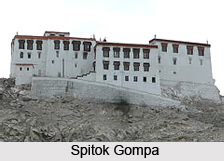 Spitok Gompa, arriving on the way improperly makes a good half day venture from Leh. This place is located 10 km upwards the north side of the Indus valley so you can hire a jeep or taxi to reach up there or if you cannot afford the fare, the easiest way is to track the way down the crossroads above the GPO and J&K tourists reception centre, and then stop any of the buses heading west along the main Srinagar highway, cause whoever has tried to walk over this way has invariably been disappointed of it. Because the route is relentlessly dull and the military have installed barbed-wire fences, which is capable of harming anyone. A break in the boredom appears 1km before Spitok in the form of museum of Ladakh and Culture and Military heritage. Here military officers have prepared self congratulatory montages of the Indian military achievements in Ladakh and also tributes have been paid to the valiant road builders who risked their lives in opening up Ladakh in front of the whole world. A couple of token rooms cover the other 2000 years of Ladakhi history.
Spitok Gompa, arriving on the way improperly makes a good half day venture from Leh. This place is located 10 km upwards the north side of the Indus valley so you can hire a jeep or taxi to reach up there or if you cannot afford the fare, the easiest way is to track the way down the crossroads above the GPO and J&K tourists reception centre, and then stop any of the buses heading west along the main Srinagar highway, cause whoever has tried to walk over this way has invariably been disappointed of it. Because the route is relentlessly dull and the military have installed barbed-wire fences, which is capable of harming anyone. A break in the boredom appears 1km before Spitok in the form of museum of Ladakh and Culture and Military heritage. Here military officers have prepared self congratulatory montages of the Indian military achievements in Ladakh and also tributes have been paid to the valiant road builders who risked their lives in opening up Ladakh in front of the whole world. A couple of token rooms cover the other 2000 years of Ladakhi history.
The old and ancient fifteenth century monastery is located in the declination of the mountains between a tight cluster of farmhouses and well-watered fields which together create picturesque scenery. It can be reached by the way from the North or South alongside a footpath through the Spitok village. The spacious roof tops provide a superb view of the surrounding from the monastery. The main complex is of less interest than the Palden Lumo Chapel that is hovering on the edge above. However the camps of the Indian army who visit here believe it to be the deity of Kali Mata but the key keeper may assure the visitors that what, many consider of black faced deity placed inside the temple to be blood thirsty Hindu goddess of death and destruction is actually the Yidam Dorje Jigjet. The coloured electric lights that are installed inside the temple enlighten the fierce and violent faces of the deities and the temple is opened up once in a year. If you have a torch, check out the 600 year old-paintings on the back wall, which is partially hidden by peculiar chaam masks used during the winter festivals.



















